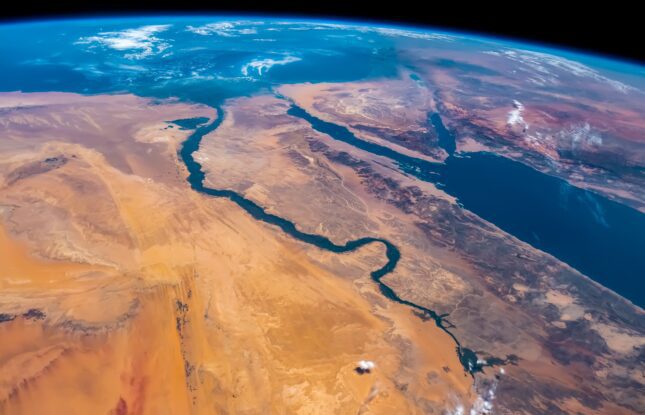-
Finding a Place for “The Planetary?”
November 5, 2024 By Simon Dalby
One of academia’s latest buzz phrases is “the planetary.” While it may seem on the surface to lack a clear connection with climate security, a closer inspection suggests that this term does have significant relevance to discussions about this key concept.
Use of “the planetary” is an attempt to compel people to think much more carefully about the current human condition. The climate crisis—as well as the extinction event we are living through—are challenging contemporary notions that humans are somehow separate from nature. In short, a relatively stable world in which our infrastructure, economies, and modes of thinking remain rooted is no longer a useful construct.
Using “the planetary” as a framework offers a challenge for our research and policy formulations to evolve and recognize the new context of a dynamic and rapidly changing planet. We need to understand ourselves as humans residing on a dynamic planet, and not living on a relatively stable one. Or, view ourselves as part of the earth system, as opposed to apart from it. If we do so, other modes of thinking must change as well.
In a paper published recently in Geoforum, I argue that climate security must be reframed so that its starting point for analysis is the earth system, or planetary context. If we examine climate security through a planetary lens, policy priorities naturally shift from a focus on national security to policies that facilitate adaptation, foster sustainable habitats for humanity, and drastically curb fossil fuels.
Rethinking Past Assumptions
National security concerns itself with keeping external threats at bay and maintaining domestic order. While progress has been made in recognizing the connections between climate change and national security, the contemporary security architecture mostly assumes that the earth is relatively stable. Military threats from abroad and dangers from internal political instability exist, but the belief is that maintaining security institutions in good working order provides the means to deal with any potential challenges.
Climate change and other ecological changes are complicating those assumptions—and demonstrating that a stable political order, or a planet will remain much as humans have known it, are no longer sensible modes of thinking. Looking at the question with the knowledge that we live in a dynamic planet system, rather than in a relatively stable and predictable world, is a game changer.
Today’s extreme climate events are causing ever more damage and creating costly repair bills. These disruptions also are upsetting the social order of many modern states, often conjuring both perverse consequences or outright denial that climate change is even happening.
Indeed, the relatively peaceful domestic status quo which exists in many modern states is a key cause of climate disruptions—mostly because the existing social order that security institutions aim to protect is built on a massive and continuing combustion of fossil fuels.
Our view of national security must be altered when dangers emerge as a result of the unintended consequences of our mode of economy, and its fuel-based energy systems.
Exploring New Implications
If a dynamic planetary system becomes the starting point for climate security discussions, three implications at odds with conventional thinking about this concept arise.
The first implication is that security now must be about facilitating adaptation. Change is upon us, so recognizing that we will be forced to adapt now creates a shift in focus from trying to maintain the status quo to ensuring that obstacles to change are removed. This is counter-intuitive to most conventional notions of national security, but our planetary condition requires new thinking.
A second change must come about via a need to think intelligently about how to build sustainable communities, and how to make ecological fecundity a key to land use and agricultural planning. For instance, finding ways to buffer downstream communities by thinking carefully about ways that upstream land use might provide for regenerative agriculture is a must. This is not a priority in traditional notions of security, but environmental security must provide conditions that allow farms, factories, and infrastructure (not to mention houses) to ride out storms—and do so without making climate change worse.
A third implication borrows from a traditional source: nuclear arms control. Such agreements limit the production of very dangerous weapons to improve common security. This is a concept that also offers a useful model for constraining the production of fossil fuels—especially in the way that arms control agreements offer complex but transparent ways of monitoring compliance. After all, it is much easier to count and track tankers, trucks, pipelines and refineries than it is to quantify and limit greenhouse gas emissions.
The Time for Change is Short
Recognizing the need to adopt “the planetary” as lens for climate security is also an acceptance that our time to grapple with the rapid change that fossil-fueled societies are adding to a dynamic planetary system is running short. If we do not act soon both to curtail fossil fuel use and make our societies much more robust to climate impacts such as storms and wildfires, then we may not have the resources to tackle this growing crisis down the road.
Delaying too long will derail much-needed future efforts to adapt to accelerating crisis and plan for a more sustainable future. Should we choose not to take action, 20th century notions of national security will appear quaint. And, ironically and tragically, we will look back from this grim future to see these outmoded views as one of the prime movers in the disaster of extreme climate disruption.
Simon Dalby is a Professor Emeritus at Wilfrid Laurier University, and author of Pyromania: Fire and Geopolitics in a Climate Disrupted World (Newcastle: Agenda, 2024), Rethinking Environmental Security (Edward Elgar 2022) and Anthropocene Geopolitics: Globalization, Security, Sustainability (University of Ottawa Press, 2020).
Sources: Columbia University Press; Earth Island; Earth System Dynamics; Geoforum; White House; Wiley
Photo credit: Aerial view of Nile River, Red Sea and Mediterranean Sea, courtesy of Emre Akkoyun/Shutterstock.com.
 A Publication of the Stimson Center.
A Publication of the Stimson Center.






